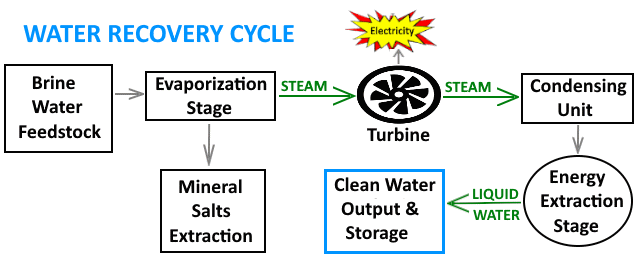
Endless River
In an attempt to design a continuos flow of water a
short cycle
regeneration strategy has been adopted as part of the
Hydro/Water Regeneration Cycle.
Connecting a lower and upper reservoir system with a regeneration water column and multiple harvesting pathways,
water may become a preferred or default energy harvesting option.
Hot Water Harvesting Cycle
By exploiting the opportunity to harness hot water from the
condensing system
output and
waste heat generated from the thermal reduction heat source units, a heat exchange "hot side" flow may be captured.
This hot water supply may act as a hot side heat source that may yield at a consistent minimum temperature of 70°C to 90°C.
Sourcing cool water from the output of a
Buoyancy column
or cooling tower you may be able to capture
a supply of cold side water at below 20°C.
By matching these hot water and cool water supplies in a custom designed heat exchange system
a temperature gradient of 50°C to 70°C might be maintained.
This 50°C+ water temperature difference may be ideal for operating a continuos low temperature
stirling
style water pumping system adequate to
regenerate water
from a lower reservoir to upper reservoir.
Heat from spent hot water flows may be allowed to disapate into incoming waste water feedstocks to act as a preheater
so that the joule energy values are not lost.
Overview of the Water Cycle Stages
In an attempt to layout a broad general overview of the clean water recovery pathways
from various brine and waste water streams.
STAGE # 1.
- Brine & Waste Water Streams
- this process cycle may purify clean water from incoming raw feedstocks of waste water and brine concentrates
and even seawater for desalination.
Water Recovery Yields
STAGE # 2.
- Thermal Reduction Process
- input of a primary heat source is used to boil/evaporate/convert waste water into steam which separates the clean water
process stream from the residues.
STAGE # 3.
- Steam Phase
- the opportunity for harvesting energy from the flow of high temperature/high pressure steam is typically achieved
with the use of a turbine or turbo machine.
STAGE # 4.
- Condensing Phase
- condensing the steam or water vapor into liquid water invokes a 1600:1 ratio volume reduction upon the phase change
which may be harnessed to operate a pump that may pump water or
compress air.
STAGE # 5.
- Hot Water stage
- the recovered liquid water is in the form of hot water which provides an opportunity to
harvest
energy similar to a shallow
geothermal
system.
STAGE # 6.
- Hydro Energy stage
- the recovered liquid water may be stored in a gravity sensitive storage reservoir that presents an additional low head
energy harvesting opportunity.
STAGE # 7.
- Clean Water Harvest
- the system produces an ongoing quantity of clean (distilled) water that is available for broad distribution as
a feedstock for drinking water, irrigation or industrial uses.
Pumped Energy Storage
Pumped Energy Storage typically refers to the pumping of a fluid into a higher energy state of potential
that may be released on demand.
Most commonly Pumped Energy Storage is applied by pumping a liquid like water into an elevated storage reservoir or
compressing a gas such as air into a storage cylinder.
This is a safe method of
non-electron
energy storage that may not require the development of new technology.
The possibility of using common abundant materials such as
water
and
air
to produce or store energy is an
attractive concept in its simplicity.
The methods used to charge, store, and discharge energy with these common materials may vary widely and may also
include using a
combination
of both materials together to amplify the efficiency effects.
One key benefit of a flexible storage system may focus on the ability to rapidly charge and reliably discharge on
an "on demand basis" by operating independent cycles with the use of a storage buffer.
The simultaneously ability to charge and discharge at the same time may prove to be an invaluable asset
in order to facilitate continuous ongoing operations.
Pumped Energy Storage may play an integral part in the implementation of a comprehensive energy
regeneration
strategy.
Pumped Energy Storage
| Type | Description |
| Hydro Energy Storage | Endless River Regeneration |
| Compressed Air | Air Compressors & Storage |
| Hydraulic Fluids | Hydraulic Accumulator |
| other | other Pumped Storage |